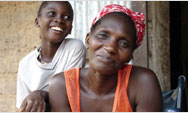A severe economic downturn coupled with ravaging levels of HIV/AIDS has made life very difficult for Zimbabweans, especially those living in semi-arid drought-prone areas. Approximately 7.5 million Zimbabweans will require food assistance in the 2003-04 agricultural season.
In October 2002, USAID launched the black-eyed bean crop as a key component of its small grains and legumes project. The objectives are to increase food security, long-term seed availability, improve diets for HIV/AIDS-affected individuals, and create income generation potential. Through USAID, seven local non-governmental organizations provided approximately 2,250 subsistence farmers in drought-prone areas with in-kind loans of black-eyed bean seed packages and agronomic extension services.
Nyarai, one of the beneficiary farmers, had never grown black-eyed beans before she joined the project. Now she speaks confidently about the nutritional, income, and food security benefits of the black-eyed bean.
|


